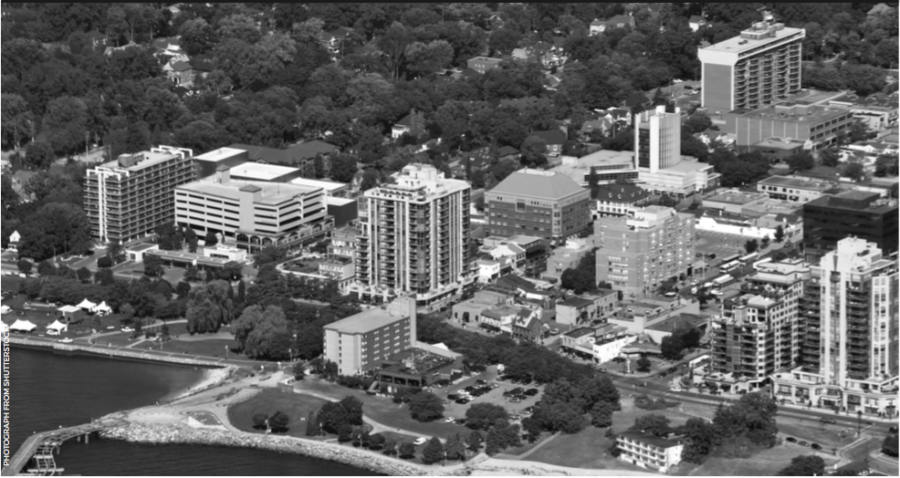
Intensification vs. Greenspace
- Marianne Meed Ward
- 31 May 2016
When does density become unhealthy for a downtown?
Intensification’s war on greenspace – and what we can do about it.
You’ve probably heard the word “intensification.” Likely in the context of defending a massive new residential over-development. Possibly as a fatalistic response to the legitimate desire to protect farmland.
In simple terms, the word means putting more people into less space.
Intensification is supposed to usher in a utopian era of urbanism, saving communities from suburban, car-dependent sprawl while protecting greenspace at the same time.
The problem is, intensification has become a war on urban greenspace that threatens to degrade the very com- munities it creates. “Intensification” is being used as a bludgeon to justify every new development of any scale in any area, while removing almost every tree, shrub or blade of grass in the way.
This must stop.
For starters, let’s rid ourselves of the word “intensification.” Intensification is a plastic word that means whatever people want it to mean. Instead, we need to talk about the kind of neighbourhoods people want to live in, as our city grows and changes.
It turns out people want to live in traditional neighbourhoods, built before the supremacy of the car: places like downtown Burlington. New communities aim to mimic these historic neighbourhoods. Planners call it “traditional town planning” or the “new urbanism.”
The key feature is walkability. But walking has to be pleasant (that’s one reason urban greenspace is important.) And walkability has to mean more than getting a bag of milk, picking up your dry cleaning, or visiting a “parkette” with a bench and a toddler slide.
If you have to get in your car to visit a park large enough to play a game of pick up football, or drive to a big-box store surrounded by parking to get groceries or hardware, or drive to another city to work, or get on a yellow bus to go to school, we haven’t achieved walk-ability.
All we’ve done is add more traffic.
Trouble is, the intensification we’re getting is almost exclusively residential, with token retail (if at all) that doesn’t come close to satisfying daily shopping needs.
We won’t build truly walkable communities until we address the commercial side of urban development, and wean ourselves off of the big-boxification of shopping, schools and employment. Residential and commercial uses are still very much separated, with big box retail, office and employment sequestered on barren, clogged and treeless roads surrounded by seas of parking, far from neighbourhoods.
We won’t build walkable communities until people can work and go to school close by. I hear regularly from residents who’d gladly take a pay cut (and some have) to walk to a job in Burlington. At a recent proposed school closure meeting, a father spoke movingly about the importance of walking his kids to school – it was their time to connect. Other parents said they’d gladly keep their small, old school within walking distance, than go to a big, brand new school far away.
Finally, we won’t build truly walkable communities until we make walking pleasant. That means beautifying our city, and adding urban greenspace. Trouble is, new developments sprawl all over their sites taking up greenspace; the taller the building, the more sprawl, with development virtually covering lot line to lot line, especially in downtown areas where land is at a premium. We end up with the equivalent of a vertical suburb, with no greenspace. “Amenity areas” are counted as balconies and party rooms.
Even in our newer “smart growth” neighbourhoods that were supposed to be the antidote to suburban sprawl, there’s almost no greenspace around homes, virtually no room to plant a backyard tree or the space to grow the root system for a large boulevard tree. New townhouse developments have even more asphalt and less greenspace. To compensate for the lack of land to absorb stormwater run- off, we build underground cisterns.
We must do better. Here are just a few steps we can take to fight intensification’s war on urban greenspace:
• Value urban greenspace as much as rural. The province has protected rural Burlington via Greenbelt legislation; our job is to protect and add to urban greenspace. We shouldn’t trade off one for the other. City folk need greenspace every bit as much as rural folk.
• Aim higher than green roofs, low flow toilets, geo-thermal heating and the like for sustainable urban development. As important as these are, they don’t replace the need for actual trees and urban greenspace.
• Revise zoning to require more setbacks, trees, permeable land, low impact development, and onsite passive greenspace in urban redevelopments.
• Take parkland dedication on redevelopments as land, rather than fees as we do now. That would instantly add urban greenspace.
By shifting the conversation from “intensification” to community, we create neighbourhoods where people want to live.
Comments 0
There are no comments


Add comment